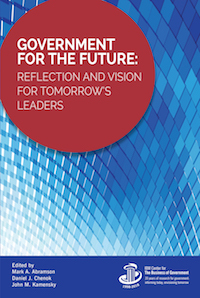
Visions of Government Reform in 2040: Data and Analytics

In the IBM Center’s new book, Government For The Future: Reflection and Vision for Tomorrow’ Leaders, Part Two of the book looks twenty years ahead offering perspectives on the future. This contribution, The Future of Data and Analytics by Shelley Metzenbaum, is the final of a multi-part series.
How should federal, state, and local governments use and communicate data and analytics in the future to improve government performance across multiple dimensions—including impact, return on spending, fairness, interaction quality, trust and understanding?
Dramatic technology advances over the last few decades in business analytics and visualization software now make it possible for federal, state, and local governments -- and those they fund or otherwise influence -- to collect, analyze, and share data in increasingly relevant and timely ways. These technology advances enable far greater functionality and significantly lower cost for data collection, analyses, and sharing. Much of what needs to happen twenty years from now could come to fruition with today’s technology with the right governance structures and incentive systems,
Specifically, by 2040, all levels of government should have implemented the following actions:
- Action 1: Fuel the front line with timely user-tailored analytics and research findings.
- Action 2: Obsess on mission, continuously innovating to improve critical processes.
- Action 3: Use visualization and other communication tools to show problems, progress, causal factors, and likely effects of corrective action in context.
- Action 4: Count and characterize events and conditions to inform continual improvement.
Action 1: Fuel the Front Line with Analytics. Twenty years from now, governments should routinely support their front line with relevant information packaged and delivered in a timely way that helps the front line deliver more successfully, courteously, efficiently, and fairly while simultaneously facilitating the front line’s ability to share and learn from their own and others’ experience.
What Will It Look Like in 2040? Government will have identified the front-line workers focusing on the government’s priority mission objectives, and given them ready access to the information they need to do their jobs well and continue to improve. If these workers need more or different information, government will be working with them to figure out what they need to know and the best way to provide that information on a timely basis. Government will also proactively determine how burdensome field-based reporting is and, if needed, work on ways to reduce the burden and enhance the value.
Action 2: Obsess on Mission. Government needs to obsess on mission while innovating to master delivery processes owned by multiple lines of business, tap external expertise and effort, and inform individual choice. It is not unusual for government agencies to innovate, but this is usually done by individual agencies at the project and program level. It is seldom done at the agency, and even less frequently at the cross-agency, level.
What Will It Look Like in 2040? Government will extensively use analytic and visualization tools that support, enlist, and motivate local action. It will do this while providing context for local priority-setting, problem-solving, opportunity advancement, and precision treatment design. Government will also have enhanced its use of analytic and visualization tools to support learning from and cooperation with others, inform individual and organizational choice, and enlist external expertise and effort.
Action 3: Use Visualization and Other Communication Tools. While recent technological developments undoubtedly enable faster, broader, and more accurate interpretation and application of analytic insights, the will and skill to analyze outcomes in context is far more essential to progress than technology, as Dr. John Snow dramatically demonstrated in London a century and a half ago when he mapped the location of houses with cholera and drinking water wells. His analytic approach allowed discovery of the contaminating pump and removal of its handle, slashing the number of cholera cases.
What Will It Look Like in 2040? Government will have made it easier to find and see governments’ objectives (within and across governments), trends on those objectives, where progress is being made, and where it is not. At the federal level, government will have created visualization tools that agencies and cross-agency teams routinely use to present mission-focused goals and objectives in the context of national and sub-national goals, historic data trends, relevant international comparisons, and other contextual information that enable causal factor identification and fair comparison. In addition, in 2040, governments will routinely collect and broadly share timely outcome data in easy-to-access affordable formats.
Action 4: Count and Characterize Events and Conditions. By 2040, all parts of government need to evolve from “hunch and surmise” to rigorous analyses. They need to figure out the “special methods” they will use to gather information that helps them understand changes in outcomes and other dimensions of performance they seek to influence. They also need to put in place governance structures that ensure continued analysis and application of analytic insights. New technologies make it more possible and affordable than ever to collect data that points to likely causes or enables more informed action or investigation.
What Will It Look Like in 2040? For common processes that governments perform—such as benefits and permit processing, fleet management, and cybersecurity—governments will have created and shared default suites of metrics and analytics that all governments adopt, adapting as needed. This will help them improve outcomes and communicate more meaningfully with citizens. In addition, organizations that try to advance the same or similar outcome objectives will create continuous-learning-and-improvement communities to develop common outcome and other indicators, analytic methods, and data standards, share platforms and principles, and learn from their own and others’ experience.



